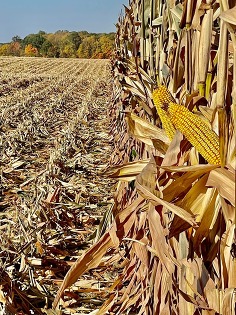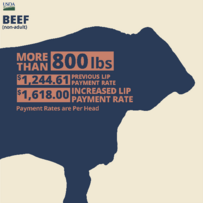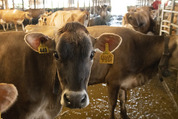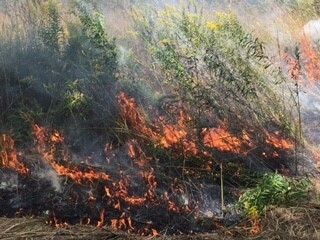
You can feel it in the air on these cool late-summer mornings. You can smell it in the evenings as the dew begins to settle across the landscape. And you know harvest is on its way as farmers across this state begin to move their combines and large farm equipment to farm fields. Yes – fall is coming!
As fall arrives, so does the end of the federal government’s fiscal year. FSA employees across the state are completing reports and finalizing work on the Farm Bill, as it also comes to a close on September 30th. Just as you farmers are awaiting the final color turn of soybeans and analyzing the percentage dryness of corn, so are U.S. Department of Agriculture employees awaiting the United States Congress’ action and decision on the next fiscal year budget and a new Farm Bill. Our offices stand ready to answer any questions through the fall months.
Thank you for trusting your county office staff to help you journey through the multitude of FSA voluntary programs. Just as I want to thank you for placing the food, feed, fiber and fuel in our lives, I also want to thank our FSA staff for all they do to guide you through the programs available to you and your farming operations.
Have a safe and productive fall
|
 State Executive Director
 The Noninsured Crop Disaster Assistance Program (NAP) provides financial assistance to you for crops that aren’t eligible for crop insurance to protect against lower yields or crops unable to be planted due to natural disasters including freeze, hail, excessive moisture, excessive wind or hurricanes, flood, excessive heat and qualifying drought (includes native grass for grazing), among others.
In order to participate, you must obtain NAP coverage for the crop year by the applicable deadline using form CCC-471 “Application for Coverage” and pay the service fee. Application closing dates vary by crop. Producers are also required to submit an acceptable crop acreage report. Additionally, NAP participants must provide:
- The quantity of all harvested production of the crop in which the producer held an interest during the crop year,
- The disposition of the harvested crop, such as whether it is marketable, unmarketable, salvaged or used differently than intended,
- Acceptable crop production records (when requested by FSA).
Producers who fail to report acreage and production information for NAP-covered crops could see reduced or zero NAP assistance. These reports are used to calculate the approved yield.
If your NAP-covered crops are affected by a natural disaster, notify your FSA office by completing Part B of form CCC-576 “Notice of Loss and Application for Payment.” This must be completed within 15 calendar days of the occurrence of the disaster or when losses become apparent or 15 days of the final harvest date. For hand-harvested crops and certain perishable crops, you must notify FSA within 72 hours of when a loss becomes apparent.
To receive benefits, you must also complete Parts D, E, F and G of the CCC-576 “Notice of Loss and Application for Payment” within 60 days of the last day of coverage for the crop year for any NAP covered crops. The CCC-576 requires acceptable appraisal information. Producers must provide evidence of production and note whether the crop was marketable, unmarketable, salvaged or used differently than intended.
Eligible crops must be commercially produced agricultural commodities for which crop insurance is not available, including perennial grass forage and grazing crops, fruits, vegetables, mushrooms, floriculture, ornamental nursery, aquaculture, turf grass, ginseng, honey, syrup, bioenergy, and industrial crops.
For more information on NAP, contact your local USDA Service Center or visit fsa.usda.gov/nap.
Annual Conservation Reserve Program (CRP) payments are typically issued in October of each year along with any earned annual farm program payments. For some programs, payments are not made until the following year. For example, payments for crop year 2019 through the Agriculture Risk Coverage and Price Loss Coverage program weren’t paid until 2020.
Farm Service Agency (FSA) program payments are issued electronically into your bank account. Payments can be delayed if FSA is not notified of changes to account and bank routing numbers. In order to receive timely payments, you need to notify your FSA servicing office of any closed bank accounts or any routing number changes due to the banks' merger.
If the bank account was closed due to the death of an individual or dissolution of an entity or partnership before the payment was issued, please notify your local FSA office as soon as possible to claim your payment.

The Livestock Indemnity Program (LIP) provides assistance to you for livestock deaths in excess of normal mortality caused by adverse weather, disease and attacks by animals reintroduced into the wild by the federal government or protected by federal law.
For disease losses, FSA county committees can accept veterinarian certifications that livestock deaths were directly related to adverse weather and unpreventable through good animal husbandry and management.
For 2023 livestock losses, you must file a notice within 30 calendar days of when the loss is first apparent. You then must provide the following supporting documentation to your local FSA office no later than 60 calendar days after the end of the calendar year in which the eligible loss condition occurred.
- Proof of death documentation
- Copy of grower’s contracts
- Proof of normal mortality documentation
Indiana FSA has established normal mortality rates for each type and weight range of eligible livestock, i.e. Adult Beef Cow = 1.5%, Non-Adult Beef Cattle (800 pounds or more) = 2.5% and Non-Adult Beef Cattle (less than 800 pounds) = 5%. These established percentages reflect losses that are considered expected or typical under “normal” conditions.
In addition to filing a notice of loss, you must also submit an application for payment by March 1, 2024.
For more information, contact your local USDA Service Center or visit fsa.usda.gov.
|

USDA announced Milk Loss Program (MLP) assistance for eligible dairy operations for milk that was dumped or removed, without compensation, from the commercial milk market due to qualifying weather events and the consequences of those weather events that inhibited delivery or storage of milk (e.g., power outages, impassable roads, infrastructure losses, etc.) during calendar years 2020, 2021 and 2022. Administered by the Farm Service Agency (FSA), signup for MLP is September 11 through October 16, 2023.
Eligibility
MLP compensates dairy operations for milk dumped or removed without compensation from the commercial milk market due to qualifying disaster events, including droughts, wildfires, hurricanes, floods, derechos, excessive heat, winter storms, freeze (including a polar vortex), and smoke exposure that occurred in the 2020, 2021 and 2022 calendar years. Tornadoes are considered a qualifying disaster event for calendar year 2022 only.
The milk loss claim period is each calendar month that milk was dumped or removed from the commercial market. Each MLP application covers the loss in a single calendar month. Milk loss that occurs in more than one calendar month due to the same qualifying weather event requires a separate application for each month.
The days that are eligible for assistance begin on the date the milk was removed or dumped and for concurrent days milk was removed or dumped. Once the dairy operation restarts milk marketing, the dairy operation is ineligible for assistance unless after restarting commercial milk marketing, additional milk is dumped due to the same qualifying disaster event. The duration of yearly claims is limited to 30 days per year for 2020, 2021 and 2022.
How to Apply
To apply for MLP, producers must submit:
- FSA-376, Milk Loss Program Application
- Milk marketing statement from the:
- Month prior to the month milk was removed or dumped.
- Affected month.
- Detailed written statement of milk removal circumstances, including the weather event type and geographic scope, what transportation limitations occurred and any information on what was done with the removed milk.
- Any other information required by the regulation.
If not previously filed with FSA, applicants must also submit all the following items within 60 days of the MLP application deadline:
- Form AD-2047, Customer Data Worksheet.
- Form CCC-902, Farm Operating Plan for an individual or legal entity.
- Form CCC-901, Member Information for Legal Entities (if applicable).
- Form FSA-510, Request for an Exception to the $125,000 Payment Limitation for Certain Programs (if applicable).
- Form CCC-860, Socially Disadvantaged, Limited Resource, Beginning and Veteran Farmer or Rancher Certification, (if applicable).
- A highly erodible land conservation (sometimes referred to as HELC) and wetland conservation certification (Form AD-1026 Highly Erodible Land Conservation (HELC) and Wetland Conservation (WC) Certification) for the MLP producer and applicable affiliates.
Most producers, especially those who have previously participated in FSA programs, will likely have these required forms already on file. However, those who are uncertain or want to confirm the status of their forms can contact their local FSA county office.
MLP Payment Calculation
The final MLP payment is determined by factoring the MLP payment calculation by the applicable MLP payment percentage.
The calculation for determining MLP payment is:
- ((Base period per cow average daily milk production x the number of milking cows in a claim period x the number of days milk was removed or dumped in a claim period) ÷ 100) x pay price per hundredweight (cwt.).
For MLP payment calculations, the milk loss base period is the first full month of production before the dumping or removal occurred.
The MLP payment percentage will be 90% for underserved producers, including socially disadvantaged, beginning, limited resource, and veteran farmers and ranchers and 75% for all other producers.
To qualify for the higher payment percentage, eligible producers must have a CCC-860, Socially Disadvantaged, Limited Resource, Beginning and Veteran Farmer or Rancher Certification, form on file with FSA for the 2022 program year.
Adjusted Gross Income (AGI) limitations do not apply to MLP, however the payment limitation for MLP is determined by the person’s or legal entity’s average adjusted gross farm income (income derived from farming, ranching and forestry operations). Specifically, a person or legal entity, other than a joint venture or general partnership, cannot receive, directly or indirectly, more than $125,000 in payments under MLP if their average adjusted gross farm income is less than 75% of their average AGI or more than $250,000 if their adjusted gross farm income is at least 75% of their average AGI.
For more information, contact your local USDA Service Center or visit fsa.usda.gov.
|
In order to claim a Farm Service Agency (FSA) payment on behalf of a deceased producer, all program conditions for the payment must have been met before the applicable producer’s date of death.
If a producer earned a FSA payment prior to his or her death, the following is the order of precedence for the representatives of the producer:
- administrator or executor of the estate
- the surviving spouse
- surviving sons and daughters, including adopted children
- surviving father and mother
- surviving brothers and sisters
- heirs of the deceased person who would be entitled to payment according to the State law
For FSA to release the payment, the legal representative of the deceased producer must file a form FSA-325 to claim the payment for themselves or an estate. The county office will verify that the application, contract, loan agreement, or other similar form requesting payment issuance, was signed by the applicable deadline by the deceased or a person legally authorized to act on their behalf at that time of application.
If the application, contract or loan agreement form was signed by someone other than the deceased participant, FSA will determine whether the person submitting the form has the legal authority to submit the form.
Payments will be issued to the respective representative’s name using the deceased program participant’s tax identification number. Payments made to representatives are subject to offset regulations for debts owed by the deceased.
FSA is not responsible for advising persons in obtaining legal advice on how to obtain program benefits that may be due to a participant who has died, disappeared or who has been declared incompetent.

The term “sodbusting” is used to identify the conversion of land from native vegetation to commodity crop production after December 23, 1985. As part of the conservation provisions of the Food Security Act of 1985, if you’re proposing to produce agricultural commodities (crops that require annual tillage including one pass planting operations and sugar cane) on land that has been determined highly erodible and that has no crop history prior to December 23, 1985, that land must be farmed in accordance with a conservation plan or system that ensures no substantial increase in soil erosion.
Eligibility for many USDA programs requires compliance with a conservation plan or system on highly erodible land (HEL) used for the production of agricultural commodities. This includes Farm Service Agency (FSA) loan, disaster assistance, safety net, price support, and conservation programs; Natural Resources Conservation Service (NRCS) conservation programs; and Risk Management Agency (RMA) Federal crop insurance.
Before you clear or prepare areas not presently under production for crops that require annual tillage, you are required to file Form AD-1026 “Highly Erodible Land Conservation and Wetland Conservation Certification,” with FSA indicating the area to be brought into production. The notification will be referred to NRCS to determine if the field is considered highly erodible land. If the field is considered HEL, you are required to implement a conservation plan or system that limits the erosion to the tolerable soil loss (T) for the predominant HEL soil on those fields.
In addition, prior to removing trees or conducting any other land manipulations that may affect wetlands, remember to update form AD-1026, to ensure you remain in compliance with the wetland conservation provisions.
Prior to purchasing or renting new cropland acres, it is recommended that you check with your local USDA Service Center to ensure your activities will be in compliance with the highly erodible land and wetland conservation provisions. Written permission from the current landowner is required for the release of this information.
For additional information on highly erodible land conservation and wetland conservation compliance, contact your local USDA Service Center.
|

FSA encourages you to be proactive in preventing the spread of wildfire. If you participate in the Conservation Reserve Program (CRP), you are responsible for fire management on your CRP acreage. The goal is to suppress the amount of fuel in the event of a wildfire while still promoting the diversity of the conservation cover.
One fire management practice includes installing firebreaks, which should be included in the contract support document and installed according to NRCS firebreak standards. Barren firebreaks will only be allowed in high-risk areas, such as transportation corridors, rural communities, and adjacent farmsteads. A conservationist must certify that there will not be an erosion hazard from the barren firebreak. If erosion becomes a problem, remedial action will be taken.
You must complete the necessary management activities outside of the Primary Nesting Season. In Indiana, the Primary Nesting Season is April 1st through August 1st each year. Remember that fireguard technical practices should be outlined in your Conservation Plan of Operations (CPO).
|
Ag producers experience worse mental health than the general population. Research, resources, and services have mostly targeted adult owners/operators and farmworkers. However, children live and work in the agricultural environment. During this webinar, we will take a closer look at the status of farm youth mental health. We will recognize causes of stress among youth living in farming and rural communities and highlight the resources available to assist families.
Tuesday, September 26
3:00 – 4:00 p.m. EDT
To participate in this free, one-hour webinar, click here to access the online registration form. Registration closes Friday, September 22. Please pass on this invitation to others you believe may be interested.
Contact AgrAbility at 800-825-4264, visit agrability.org/training-category/upcoming, or email agrability@agrability.org if you have questions.

Is the new Controlled Environment crop insurance right for you? Find out with USDA’s Risk Management Agency.
The USDA is introducing a new Federal Crop Insurance program designed to provide greenhouse growers an opportunity to insure against losses due to destruction orders based on detection of plant disease vectors.
Details on upcoming virtual sessions scheduled for September 21, 22 and 26 can be found here.
USDA is hosting an in-person public session on OCT. 12 in HUDSONVILLE, MICH., to introduce the program and answer any questions you may have. Learn more and see the schedule of the session’s exact time and location. Learn More
|
RMA announced that it has updated crop insurance options for small and diversified farmers through improvements to the Whole-Farm Revenue Protection (WRFP) and Micro Farm insurance plans. These improvements are a direct response from feedback received from producers during the RMA roadshows last fall. Both WFRP and Micro farm policies are excellent insurance options for specialty crop, organic, urban, and direct-market producers.
Learn more about updates to WFRP and Micro farm policies and how to find a local approved insurance provider near you.
Are you interested in learning more about FSA Farm Loan Programs. Be on the lookout later this month for our 2023 Farm Loan Program newsletter.
USDA announced loan interest rates for September 2023, which were effective September 1, 2023. USDA’s FSA loans provide important access to capital to help agricultural producers start or expand their farming operation, purchase equipment and storage structures, or meet cash flow needs.
FSA also offers guaranteed loans through commercial lenders at rates set by those lenders.
Check your eligibility for FSA loans by utilizing the Farm Loan Assistance Tool. Find out which of these loans may be right for you by using our Farm Loan Discovery Tool.
Producers can explore available options on all FSA loan options at fsa.usda.gov or by contacting your local USDA Service Center.
2023 Indiana FSA Important Deadline Dates
September 15 - Final Acreage Reporting Date for Cucumbers Planted 6/1 - 8/15 in Knox County
October 2 - NAP Sales Closing Date for Value loss Crops for the Following Year (Flowers for Fresh Cut, Onion Sets, Turfgrass Sod, Christmas Trees, Aquaculture, Ginseng, Mushrooms, etc...)
October 2 - Final Acreage Reporting Date for Value Loss & Controlled Environment Crop (for coming program year)
October 2 - NAP Sales Closing Date for Garlic, Wheat, Barley, Rye and Mint for the Following Year’s Crop
October 2 - Final Date to Submit Receipts for 2023 Mid-Contract Management Practices on CRP Acreage
October 9 - Offices Closed in Observance of Columbus Day
October 16 - Final Date to Submit Application for the Milk Loss Program (MLP)
October 31 - Final Date to Apply for Reimbursement through the Organic Certification Cost Share Program (OCCSP) (expenses 10-01-2022 through 09-30-2023)
October 31 - Application Deadline to Submit an Application for the Section 22007 of the Inflation Reduction Act – Discrimination Financial Assistance Program
Ongoing - Signup for Continuous CRP
Ongoing – Submit an Application for a Farm Storage Facility Loan
Continuous - Submit an Application for FSA Farm Loans
Continuous - Signup for Local County Office FSA Text Alerts - Text Your Service Center Keyword to FSANOW (372-669)
Continuous – Sign up for GovDelivery Newsletters, Bulletins and Indiana Press Releases (Subscribe to USDA Emails for Farmers | Farmers.gov)
|